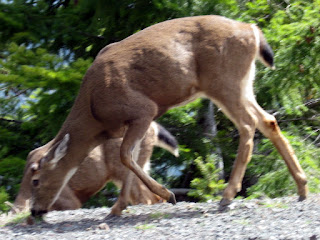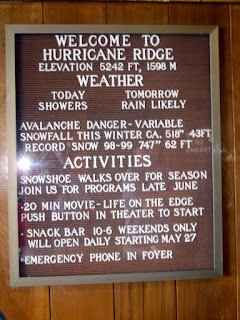Well, we got a late start out of the RV park this morning, and, we didn't realize that Olympic NP was as far as it was over on the beautiful Olympic Pennisula, in the farthest northwest part of the state.
From Wiki: The park can be divided into four basic regions: the Pacific coastline, alpine areas, the west side temperate rainforest and the forests of the drier east side. U.S. President Theodore Roosevelt originally created Mount Olympus National Monument in 1909[1] and after Congress voted to authorize a re-designation to National Park status, President Franklin Roosevelt signed the legislation in 1938. In 1976, Olympic National Park became an International Biosphere Reserve, and in 1981 it was designated a World Heritage Site. In 1988, Congress designated 95 percent of the park as the Olympic Wilderness.
On the way up to Hurricane Ridge, we encountered some native wildlife. These deer just walked along and were eating what appeared to be gravel. But I guess there were little blades of something that had their attention. Wen we stopped at this one overlook, four Canada Gray Jays immediately "pounced" down from their roosts and demanded a snack.
Perched on a snow marker pole.
Had the Jays eating out of my hand. Must be a lot of folks attending to these bold birds. They had no fear of humans.
I never tried offering an apple to one of the deer. Plus, there is a fine for feeding the animals, so it's best I didn't try.
Yum! Pea Gravel!
Hurricane Ridge was quite pleasant in spite of it's name. But, we read where it can be violent up here during the winter storms.
Check out the snow depths. We actuall had to drive around a few small slides that had covered most of a lane of the road coming up to the ridge.
Large snow blowers on standby for a late winter storm.
The volunteer ranger told us that they had an unusually bad winter, late, and normally at this time of year, most snow has already melted. Hmmm! Really? The valleys seemed to be endless across the ridges. Firs and other coniferous typs trees were also endless and seemed to just totally cover the hill sides.
The dark areas in these photos are trees. Logging as you might guess, is a very big business in Washington. Well, most of the roads in the Park were still closed, so we bactracked down the hill 17 miles and onto CA101 in Port Angeles, and headed back towards our MH in Tacoma, some 80 miles away. We did however wanted to take a little different way back though.
So, we drove to Bainbridge Island, grabbed us Quiznos sub, and took the ferry across Puget Sound to downtown Seattle.
Wow! Seattle is a huge city. Al, don't go here, you would probably break out in hives and have a panic attack. :-) My friend Al Bossence and his wife Kelly of The Bayfield Bunch are notorious dry campers and like wide open spaces when they are in the great southwest, and avoid large jungles of concrete and people if at all possible. We did hustle out of the city quickly, through a downpour too. YUK!
So, here it is, Sunday morning 5/15 and it is still raining, and is supposed to all day today and tomorrow, and Tuesday. We are outta here. Spokane tonight, we hope, and Missoula tomorrow. So, till our next blog, RVing Beach Bums.
























won't say enjoy the greater Seattle area!..it is one of those places that are better just to drive through and not stop!..drive safely as you head to Spokane and on to Missoula!!
ReplyDeletegreat tour of Hurricane Ridge!..we went to Sequim a couple of years ago and that was as close as we got to it!..!..next time!!
Great pictures, but that is a lot of snow!
ReplyDeleteNow that's a lot of snow. Sounds like you had a long day of driving.
ReplyDeleteYep, any urban center with a population of more than 10 people is to be avoided for sure. I remember seeing snow loads along the road like that in Estes Park, Colorado.
ReplyDelete